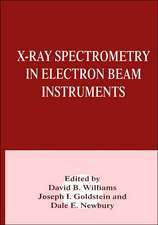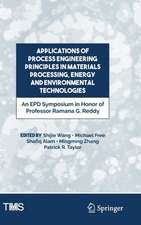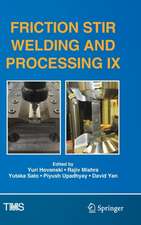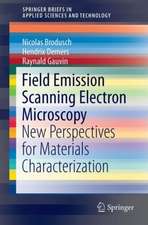Scanning Electron Microscopy and X-Ray Microanalysis: Third Edition
Autor Joseph Goldstein, Dale E. Newbury, David C. Joy, Charles E. Lyman, Patrick Echlin, Eric Lifshin, Linda Sawyer, J.R. Michaelen Limba Engleză Paperback – 31 mai 2013
Preț: 730.39 lei
Preț vechi: 859.29 lei
-15% Nou
Puncte Express: 1096
Preț estimativ în valută:
139.80€ • 144.07$ • 118.02£
139.80€ • 144.07$ • 118.02£
Carte tipărită la comandă
Livrare economică 03-17 martie
Preluare comenzi: 021 569.72.76
Specificații
ISBN-13: 9781461349693
ISBN-10: 1461349699
Pagini: 720
Ilustrații: XIX, 689 p.
Dimensiuni: 178 x 254 x 38 mm
Greutate: 1.35 kg
Ediția:3rd ed. 2003. Softcover reprint of the original 3rd ed. 2003
Editura: Springer Us
Colecția Springer
Locul publicării:New York, NY, United States
ISBN-10: 1461349699
Pagini: 720
Ilustrații: XIX, 689 p.
Dimensiuni: 178 x 254 x 38 mm
Greutate: 1.35 kg
Ediția:3rd ed. 2003. Softcover reprint of the original 3rd ed. 2003
Editura: Springer Us
Colecția Springer
Locul publicării:New York, NY, United States
Public țintă
Professional/practitionerCuprins
1. Introduction.- 1.1. Imaging Capabilities.- 1.2. Structure Analysis.- 1.3. Elemental Analysis.- 1.4. Summary and Outline of This Book.- Appendix A. Overview of Scanning Electron Microscopy.- Appendix B. Overview of Electron Probe X-Ray Microanalysis.- References.- 2. The SEM and Its Modes of Operation.- 2.1. How the SEM Works.- 2.1.1. Functions of the SEM Subsystems.- 2.1.1.1. Electron Gun and Lenses Produce a Small Electron Beam.- 2.1.1.2. Deflection System Controls Magnification.- 2.1.1.3. Electron Detector Collects the Signal.- 2.1.1.4. Camera or Computer Records the Image.- 2.1.1.5. Operator Controls.- 2.1.2. SEM Imaging Modes.- 2.1.2.1. Resolution Mode.- 2.1.2.2. High-Current Mode.- 2.1.2.3. Depth-of-Focus Mode.- 2.1.2.4. Low-Voltage Mode.- 2.1.3. Why Learn about Electron Optics?.- 2.2. Electron Guns.- 2.2.1. Tungsten Hairpin Electron Guns.- 2.2.1.1. Filament.- 2.2.1.2. Grid Cap.- 2.2.1.3. Anode.- 2.2.1.4. Emission Current and Beam Current.- 2.2.1.5. Operator Control of the Electron Gun.- 2.2.2. Electron Gun Characteristics.- 2.2.2.1. Electron Emission Current.- 2.2.2.2. Brightness.- 2.2.2.3. Lifetime.- 2.2.2.4. Source Size, Energy Spread, Beam Stability.- 2.2.2.5. Improved Electron Gun Characteristics.- 2.2.3. Lanthanum Hexaboride (LaB6) Electron Guns.- 2.2.3.1. Introduction.- 2.2.3.2. Operation of the LaB6 Source.- 2.2.4. Field Emission Electron Guns.- 2.3. Electron Lenses.- 2.3.1. Making the Beam Smaller.- 2.3.1.1. Electron Focusing.- 2.3.1.2. Demagnification of the Beam.- 2.3.2. Lenses in SEMs.- 2.3.2.1. Condenser Lenses.- 2.3.2.2. Objective Lenses.- 2.3.2.3. Real and Virtual Objective Apertures.- 2.3.3. Operator Control of SEM Lenses.- 2.3.3.1. Effect of Aperture Size.- 2.3.3.2. Effect of Working Distance.- 2.3.3.3. Effect of Condenser Lens Strength.- 2.3.4. Gaussian Probe Diameter.- 2.3.5. Lens Aberrations.- 2.3.5.1. Spherical Aberration.- 2.3.5.2. Aperture Diffraction.- 2.3.5.3. Chromatic Aberration.- 2.3.5.4. Astigmatism.- 2.3.5.5. Aberrations in theObjective Lens.- 2.4. Electron Probe Diameter versus Electron Probe Current.- 2.4.1. Calculation of dmin and imax.- 2.4.1.1. Minimum Probe Size.- 2.4.1.2. Minimum Probe Size at 10-30 kV.- 2.4.1.3. Maximum Probe Current at 10-30 kV.- 2.4.1.4. Low-Voltage Operation.- 2.4.1.5. Graphical Summary.- 2.4.2. Performance in the SEM Modes.- 2.4.2.1. Resolution Mode.- 2.4.2.2. High-Current Mode.- 2.4.2.3. Depth-of-Focus Mode.- 2.4.2.4. Low-Voltage SEM.- 2.4.2.5. Environmental Barriers to High-Resolution Imaging.- References.- 3. Electron Beam–Specimen Interactions.- 3.1. The Story So Far.- 3.2. The Beam Enters the Specimen.- 3.3. The Interaction Volume.- 3.3.1. Visualizing the Interaction Volume.- 3.3.2. Simulating the Interaction Volume.- 3.3.3. Influence of Beam and Specimen Parameters on the Interaction Volume.- 3.3.3.1. Influence of Beam Energy on the Interaction Volume.- 3.3.3.2. Influence of Atomic Number on the Interaction Volume.- 3.3.3.3. Influence of Specimen Surface Tilt on the Interaction Volume.- 3.3.4. Electron Range: A Simple Measure of the Interaction Volume.- 3.3.4.1. Introduction.- 3.3.4.2. The Electron Range at Low Beam Energy.- 3.4. Imaging Signals from the Interaction Volume.- 3.4.1. Backscattered Electrons.- 3.4.1.1. Atomic Number Dependence of BSE.- 3.4.1.2. Beam Energy Dependence of BSE.- 3.4.1.3. Tilt Dependence of BSE.- 3.4.1.4. Angular Distribution of BSE.- 3.4.1.5. Energy Distribution of BSE.- 3.4.1.6. Lateral Spatial Distribution of BSE.- 3.4.1.7. Sampling Depth of BSE.- 3.4.2. Secondary Electrons.- 3.4.2.1. Definition and Origin of SE.- 3.4.2.2. SE Yield with Primary Beam Energy.- 3.4.2.3. SE Energy Distribution.- 3.4.2.4. Range and Escape Depth of SE.- 3.4.2.5. Relative Contributions of SE1 and SE2.- 3.4.2.6. Specimen Composition Dependence of SE.- 3.4.2.7. Specimen Tilt Dependence of SE.- 3.4.2.8. Angular Distribution of SE.- References.- 4. Image Formation and Interpretation.- 4.1. The Story So Far.- 4.2. The Basic SEM Imaging Process.- 4.2.1.Scanning Action.- 4.2.2. Image Construction (Mapping).- 4.2.2.1. Line Scans.- 4.2.2.2. Image (Area) Scanning.- 4.2.2.3. Digital Imaging: Collection and Display.- 4.2.3. Magnification.- 4.2.4. Picture Element (Pixel) Size.- 4.2.5. Low-Magnification Operation.- 4.2.6. Depth of Field (Focus).- 4.2.7. Image Distortion.- 4.2.7.1. Projection Distortion: Gnomonic Projection.- 4.2.7.2. Projection Distortion: Image Foreshortening.- 4.2.7.3. Scan Distortion: Pathological Defects.- 4.2.7.4. Moiré Effects.- 4.3. Detectors.- 4.3.1. Introduction.- 4.3.2. Electron Detectors.- 4.3.2.1. Everhart–Thornley Detector.- 4.3.2.2. “Through-the-Lens” (TTL) Detector.- 4.3.2.3. Dedicated Backscattered Electron Detectors.- 4.4. The Roles of the Specimen and Detector in Contrast Formation.- 4.4.1. Contrast.- 4.4.2. Compositional (Atomic Number) Contrast.- 4.4.2.1. Introduction.- 4.4.2.2. Compositional Contrast with Backscattered Electrons.- 4.4.3. Topographic Contrast.- 4.4.3.1. Origins of Topographic Contrast.- 4.4.3.2. Topographic Contrast with the Everhart–Thornley Detector.- 4.4.3.3. Light-Optical Analogy.- 4.4.3.4. Interpreting Topographic Contrast with Other Detectors.- 4.5. Image Quality.- 4.6. Image Processing for the Display of Contrast Information.- 4.6.1. The Signal Chain.- 4.6.2. The Visibility Problem.- 4.6.3. Analog and Digital Image Processing.- 4.6.4. Basic Digital Image Processing.- 4.6.4.1. Digital Image Enhancement.- 4.6.4.2. Digital Image Measurements.- References.- 5. Special Topics in Scanning Electron Microscopy.- 5.1. High-Resolution Imaging.- 5.1.1. The Resolution Problem.- 5.1.2. Achieving High Resolution at High Beam Energy.- 5.1.3. High-Resolution Imaging at Low Voltage.- 5.2. STEM-in-SEM: High Resolution for the Special Case of Thin Specimens.- 5.3. Surface Imaging at Low Voltage.- 5.4. Making Dimensional Measurements in the SEM.- 5.5. Recovering the Third Dimension: Stereomicroscopy.- 5.5.1. Qualitative Stereo Imaging and Presentation.- 5.5.2. Quantitative Stereo Microscopy.- 5.6. Variable-Pressure and Environmental SEM.- 5.6.1. Current Instruments.- 5.6.2. Gas in the Specimen Chamber.- 5.6.2.1. Units of Gas Pressure.- 5.6.2.2. The Vacuum System.- 5.6.3. Electron Interactions with Gases.- 5.6.4. The Effect of the Gas on Charging.- 5.6.5. Imaging in the ESEM and the VPSEM.- 5.6.6. X-Ray Microanalysis in the Presence of a Gas.- 5.7. Special Contrast Mechanisms.- 5.7.1. Electric Fields.- 5.7.2. Magnetic Fields.- 5.7.2.1. Type 1 Magnetic Contrast.- 5.7.2.2. Type 2 Magnetic Contrast.- 5.7.3. Crystallographic Contrast.- 5.8. Electron Backscatter Patterns.- 5.8.1. Origin of EBSD Patterns.- 5.8.2. Hardware for EBSD.- 5.8.3. Resolution of EBSD.- 5.8.3.1. Lateral Spatial Resolution.- 5.8.3.2. Depth Resolution.- 5.8.4. Applications.- 5.8.4.1. Orientation Mapping.- 5.8.4.2. Phase Identification.- References.- 6. Generation of X-Rays in the SEM Specimen.- 6.1. Continuum X-Ray Production (Bremsstrahlung).- 6.2. Characteristic X-Ray Production.- 6.2.1. Origin.- 6.2.2. Fluorescence Yield.- 6.2.3. Electron Shells.- 6.2.4. Energy-Level Diagram.- 6.2.5. Electron Transitions.- 6.2.6. Critical Ionization Energy.- 6.2.7. Moseley’s Law.- 6.2.8. Families of Characteristic Lines.- 6.2.9. Natural Width of Characteristic X-Ray Lines.- 6.2.10. Weights of Lines.- 6.2.11. Cross Section for Inner Shell Ionization.- 6.2.12. X-Ray Production in Thin Foils.- 6.2.13. X-Ray Production in Thick Targets.- 6.2.14. X-Ray Peak-to-Background Ratio.- 6.3. Depth of X-Ray Production (X-Ray Range).- 6.3.1. Anderson–Hasler X-Ray Range.- 6.3.2. X-Ray Spatial Resolution.- 6.3.3. Sampling Volume and Specimen Homogeneity.- 6.3.4.Depth Distribution of X-Ray Production, ?(?z).- 6.4. X-Ray Absorption.- 6.4.1. Mass Absorption Coefficient for an Element.- 6.4.2. Effect of Absorption Edge on Spectrum.- 6.4.3. Absorption Coefficient for Mixed-Element Absorbers.- 6.5. X-Ray Fluorescence.- 6.5.1. Characteristic Fluorescence.- 6.5.2. Continuum Fluorescence.- 6.5.3. Range of Fluorescence Radiation.- References.- 7. X-Ray Spectral Measurement: EDS and WDS.- 7.1. Introduction.- 7.2. Energy-Dispersive X-Ray Spectrometer.- 7.2.1. Operating Principles.- 7.2.2. The Detection Process.- 7.2.3. Charge-to-Voltage Conversion.- 7.2.4. Pulse-Shaping Linear Amplifier and Pileup Rejection Circuitry.- 7.2.5. The Computer X-Ray Analyzer.- 7.2.6. Digital Pulse Processing.- 7.2.7. Spectral Modification Resulting from the Detection Process.- 7.2.7.1. Peak Broadening.- 7.2.7.2. Peak Distortion.- 7.2.7.3. Silicon X-Ray Escape Peaks.- 7.2.7.4. Absorption Edges.- 7.2.7.5. Silicon Internal Fluorescence Peak.- 7.2.8. Artifacts from the Detector Environment.- 7.2.9. Summary of EDS Operation and Artifacts.- 7.3. Wavelength-Dispersive Spectrometer.- 7.3.1. Introduction.- 7.3.2. Basic Description.- 7.3.3. Diffraction Conditions.- 7.3.4. Diffracting Crystals.- 7.3.5. The X-Ray Proportional Counter.- 7.3.6. Detector Electronics.- 7.4. Comparison of Wavelength-Dispersive Spectrometers with Conventional Energy-Dispersive Spectrometers.- 7.4.1. Geometric Collection Efficiency.- 7.4.2. Quantum Efficiency.- 7.4.3. Resolution.- 7.4.4. Spectral Acceptance Range.- 7.4.5. Maximum Count Rate.- 7.4.6. Minimum Probe Size.- 7.4.7. Speed of Analysis.- 7.4.8. Spectral Artifacts.- 7.5. Emerging Detector Technologies.- 7.5.1. X-Ray Microcalorimetery.- 7.5.2. Silicon Drift Detectors.- 7.5.3. Parallel Optic Diffraction-Based Spectrometers.- References.- 8. Qualitative X-Ray Analysis.- 8.1. Introduction.- 8.2. EDS Qualitative Analysis.- 8.2.1. X-Ray Peaks.- 8.2.2. Guidelines for EDS Qualitative Analysis.- 8.2.2.1. General Guidelines for EDS Qualitative Analysis.- 8.2.2.2. Specific Guidelines for EDS Qualitative Analysis.- 8.2.3. Examples of Manual EDS Qualitative Analysis.- 8.2.4. Pathological Overlaps in EDS Qualitative Analysis.- 8.2.5. Advanced Qualitative Analysis: Peak Stripping.- 8.2.6. Automatic Qualitative EDS Analysis.- 8.3. WDS Qualitative Analysis.- 8.3.1. Wavelength-Dispersive Spectrometry of X-Ray Peaks.- 8.3.2. Guidelines for WDS Qualitative Analysis.- References.- 9. Quantitative X-Ray Analysis: The Basics.- 9.1. Introduction.- 9.2. Advantages of Conventional Quantitative X-Ray Microanalysis in the SEM.- 9.3. Quantitative Analysis Procedures: Flat-Polished Samples.- 9.4. The Approach to X-Ray Quantitation: The Need for Matrix Corrections.- 9.5. The Physical Origin of Matrix Effects.- 9.6. ZAF Factors in Microanalysis.- 9.6.1. Atomic number effect, Z.- 9.6.1.1. Effect of Backscattering (R) and Energy Loss (S ).- 9.6.1.2. X-Ray Generation with Depth, ?(?z).- 9.6.2. X-Ray Absorption Effect, A.- 9.6.3. X-Ray Fluorescence, F.- 9.7. Calculation of ZAF Factors.- 9.7.1. Atomic Number Effect, Z.- 9.7.2. Absorption correction, A.- 9.7.3. Characteristic Fluorescence Correction, F.- 9.7.4. Calculation of ZAF.- 9.7.5. The Analytical Total.- 9.8. Practical Analysis.- 9.8.1. Examples of Quantitative Analysis.- 9.8.1.1. Al–Cu Alloys.- 9.8.1.2. Ni–10 wt% Fe Alloy.- 9.8.1.3. Ni–38.5 wt% Cr–3.0 wt% Al Alloy.- 9.8.1.4. Pyroxene: 53.5 wt% SiO2, 1.11 wt% Al2O3, 0.62 wt% Cr2O3, 9.5 wt% FeO, 14.1 wt% MgO, and 21.2 wt% CaO.- 9.8.2. Standardless Analysis.- 9.8.2.1. First-Principles Standardless Analysis.- 9.8.2.2. “Fitted-Standards” Standardless Analysis.- 9.8.3. Special Procedures for Geological Analysis.- 9.8.3.1. Introduction.- 9.8.3.2. Formulation of the Bence–Albee Procedure.- 9.8.3.3. Application of the Bence–Albee Procedure.- 9.8.3.4. Specimen Conductivity.- 9.8.4. Precision and Sensitivity in X-Ray Analysis.- 9.8.4.1. Statistical Basis for Calculating Precision and Sensitivity.- 9.8.4.2. Precision of Composition.- 9.8.4.3. Sample Homogeneity.- 9.8.4.4. Analytical Sensitivity.- 9.8.4.5. Trace Element Analysis.- 9.8.4.6. Trace Element Analysis Geochronologic Applications.- 9.8.4.7. Biological and Organic Specimens.- References.- 10. Special Topics in Electron Beam X-Ray Microanalysis.- 10.1. Introduction.- 10.2. Thin Film on a Substrate.- 10.3. Particle Analysis.-10.3.1. Particle Mass Effect.- 10.3.2. Particle Absorption Effect.- 10.3.3. Particle Fluorescence Effect.- 10.3.4. Particle Geometric Effects.- 10.3.5. Corrections for Particle Geometric Effects.- 10.3.5.1. The Consequences of Ignoring Particle Effects.- 10.3.5.2. Normalization.- 10.3.5.3. Critical Measurement Issues for Particles.- 10.3.5.4. Advanced Quantitative Methods for Particles.- 10.4. Rough Surfaces.- 10.4.1. Introduction.- 10.4.2. Rough Specimen Analysis Strategy.- 10.4.2.1. Reorientation.- 10.4.2.2. Normalization.- 10.4.2.3. Peak-to-Background Method.- 10.5. Beam-Sensitive Specimens (Biological, Polymeric).- 10.5.1. Thin-Section Analysis.- 10.5.2. Bulk Biological and Organic Specimens.- 10.6. X-Ray Mapping.- 10.6.1. Relative Merits of WDS and EDS for Mapping.- 10.6.2. Digital Dot Mapping.- 10.6.3. Gray-Scale Mapping.- 10.6.3.1. The Need for Scaling in Gray-Scale Mapping.- 10.6.3.2. Artifacts in X-Ray Mapping.- 10.6.4. Compositional Mapping.- 10.6.4.1. Principles of Compositional Mapping.- 10.6.4.2. Advanced Spectrum Collection Strategies for Compositional Mapping.- 10.6.5. The Use of Color in Analyzing and Presenting X-Ray\ Maps.- 10.6.5.1. Primary Color Superposition.- 10.6.5.2. Pseudocolor Scales.- 10.7. Light Element Analysis.- 10.7.1. Optimization of Light Element X-Ray Generation.- 10.7.2. X-Ray Spectrometry of the Light Elements.- 10.7.2.1. Si EDS.- 10.7.2.2. WDS.- 10.7.3. Special Measurement Problems for the Light Elements.- 10.7.3.1. Contamination.- 10.7.3.2. Overvoltage Effects.- 10.7.3.3. Absorption Effects.- 10.7.4.Light Element Quantification.- 10.8. Low-Voltage Microanalysis.- 10.8.1. “Low-Voltage” versus “Conventional” Microanalysis.- 10.8.2. X-Ray Production Range.- 10.8.2.1. Contribution of the Beam Size to the X-Ray Analytical Resolution.- 10.8.2.2. A Consequence of the X-Ray Range under Low-Voltage Conditions.- 10.8.3. X-Ray Spectrometry in Low-Voltage Microanalysis.- 10.8.3.1. The Oxygen and Carbon Problem.- 10.8.3.2. Quantitative X-Ray Microanalysis at Low Voltage.- 10.9. Report of Analysis.- References.- 11. Specimen Preparation of Hard Materials: Metals, Ceramics, Rocks, Minerals, Microelectronic and Packaged Devices, Particles, and Fibers.- 11.1. Metals.- 11.1.1. Specimen Preparation for Surface Topography.- 11.1.2. Specimen Preparation for Microstructural and Microchemical Analysis.- 11.1.2.1. Initial Sample Selection and Specimen Preparation Steps.- 11.1.2.2. Final Polishing Steps.- 11.1.2.3. Preparation for Microanalysis.- 11.2. Ceramics and Geological Samples.- 11.2.1. Initial Specimen Preparation: Topography and Microstructure.- 11.2.2. Mounting and Polishing for Microstructural and Microchemical Analysis.- 11.2.3. Final Specimen Preparation for Microstructural and Microchemical Analysis.- 11.3. Microelectronics and Packages.- 11.3.1. Initial Specimen Preparation.- 11.3.2. Polishing.- 11.3.3. Final Preparation.- 11.4. Imaging of Semiconductors.- 11.4.1. Voltage Contrast.- 11.4.2. Charge Collection.- 11.5. Preparation for Electron Diffraction in the SEM.- 11.5.1. Channeling Patterns and Channeling Contrast.- 11.5.2. Electron Backscatter Diffraction.- 11.6. Special Techniques.- 11.6.1. Plasma Cleaning.- 11.6.2. Focused-Ion-Beam Sample Preparation for SEM.- 11.6.2.1. Application of FIB for Semiconductors.- 11.6.2.2. Applications of FIB in Materials Science.- 11.7.Particles and Fibers.- 11.7.1. Particle Substrates and Supports.- 11.7.1.1. Bulk Particle Substrates.- 11.7.1.2. Thin Particle Supports.- 11.7.2. Particle Mounting Techniques.- 11.7.3. Particles Collected on Filters.- 11.7.4. Particles in a Solid Matrix.- 11.7.5. Transfer of Individual Particles.- References.- 12. Specimen Preparation of Polymer Materials.- 12.1. Introduction.- 12.2. Microscopy of Polymers.- 12.2.1. Radiation Effects.- 12.2.2. Imaging Compromises.- 12.2.3. Metal Coating Polymers for Imaging.- 12.2.4. X-Ray Microanalysis of Polymers.- 12.3. Specimen Preparation Methods for Polymers.- 12.3.1. Simple Preparation Methods.- 12.3.2. Polishing of Polymers.- 12.3.3. Microtomy of Polymers.- 12.3.4. Fracture of Polymer Materials.- 12.3.5. Staining of Polymers.- 12.3.5.1. Osmium Tetroxide and Ruthenium Tetroxide.- 12.3.5.2. Ebonite.- 12.3.5.3. Chlorosulfonic Acid and Phosphotungstic Acid.- 12.3.6. Etching of Polymers.- 12.3.7. Replication of Polymers.- 12.3.8. Rapid Cooling and Drying Methods for Polymers.- 12.3.8.1. Simple Cooling Methods.- 12.3.8.2. Freeze-Drying.- 12.3.8.3. Critical-Point Drying.- 12.4. Choosing Specimen Preparation Methods.- 12.4.1. Fibers.- 12.4.2. Films and Membranes.- 12.4.3. Engineering Resins and Plastics.- 12.4.4. Emulsions and Adhesives.- 12.5. Problem-Solving Protocol.- 12.6. Image Interpretation and Artifacts.- References.- 13. Ambient-Temperature Specimen Preparation of Biological Material.- 13.1. Introduction.- 13.2. Preparative Procedures for the Structural SEM of Single Cells, Biological Particles, and Fibers.- 13.2.1. Particulate, Cellular, and Fibrous Organic Material.-13.2.2. Dry Organic Particles and Fibers.- 13.2.2.1. Organic Particles and Fibers on a Filter.- 13.2.2.2. Organic Particles and Fibers Entrained within a Filter.- 13.2.2.3. Organic Particulate Matter Suspended in a Liquid.- 13.2.2.4. Manipulating Individual Organic Particles.- 13.3. Preparative Procedures for the Structural Observation of Large Soft Biological Specimens.- 13.3.1. Introduction.- 13.3.2. Sample Handling before Fixation.- 13.3.3. Fixation.- 13.3.4. Microwave Fixation.- 13.3.5. Conductive Infiltration.- 13.3.6. Dehydration.- 13.3.7. Embedding.- 13.3.8. Exposing the Internal Contents of Bulk Specimens.- 13.3.8.1. Mechanical Dissection.- 13.3.8.2. High-Energy-Beam Surface Erosion.- 13.3.8.3. Chemical Dissection.- 13.3.8.4. Surface Replicas and Corrosion Casts.- 13.3.9. Specimen Supports and Methods of Sample Attachment.- 13.3.10. Artifacts.- 13.4. Preparative Procedures for the in Situ Chemical Analysis of Biological Specimens in the SEM.- 13.4.1. Introduction.- 13.4.2. Preparative Procedures for Elemental Analysis Using X-Ray Microanalysis.- 13.4.2.1. The Nature and Extent of the Problem.- 13.4.2.2. Types of Sample That May be Analyzed.- 13.4.2.3. The General Strategy for Sample Preparation.- 13.4.2.4. Criteria for Judging Satisfactory Sample Preparation.- 13.4.2.5. Fixation and Stabilization.- 13.4.2.6. Precipitation Techniques.- 13.4.2.7. Procedures for Sample Dehydration, Embedding, and Staining.- 13.4.2.8. Specimen Supports.- 13.4.3. Preparative Procedures for Localizing Molecules Using Histochemistry.- 13.4.3.1. Staining and Histochemical Methods.- 13.4.3.2. Atomic Number Contrast with Backscattered Electrons.- 13.4.4. Preparative Procedures for Localizing Macromolecues Using Immunocytochemistry.- 13.4.4.1. Introduction.- 13.4.4.2. The Antibody–Antigen Reaction.- 13.4.4.3. General Features of Specimen Preparation for Immunocytochemistry.- 13.4.4.4. Imaging Procedures in the SEM.- References.- 14. Low-Temperature Specimen Preparation.- 14.1. Introduction.- 14.2. The Properties of Liquid Water and Ice.- 14.3. Conversion of Liquid Water to Ice.- 14.4. Specimen Pretreatment before Rapid (Quench) Cooling.- 14.4.1. Minimizing Sample Size and Specimen Holders.- 14.4.2. Maximizing Undercooling.- 14.4.3. Altering the Nucleation Process.- 14.4.4. Artificially Depressing the Sample Freezing Point.- 14.4.5. Chemical Fixation.- 14.5. Quench Cooling.- 14.5.1. Liquid Cryogens.- 14.5.2. Solid Cryogens.- 14.5.3. Methods for Quench Cooling.- 14.5.4. Comparison of Quench Cooling Rates.- 14.6. Low-Temperature Storage and Sample Transfer.- 14.7. Manipulation of Frozen Specimens: Cryosectioning, Cryofracturing, and Cryoplaning.- 14.7.1. Cryosectioning.- 14.7.2. Cryofracturing.- 14.7.3. Cryopolishing or Cryoplaning.- 14.8. Ways to Handle Frozen Liquids within the Specimen.- 14.8.1. Frozen-Hydrated and Frozen Samples.- 14.8.2. Freeze-Drying.- 14.8.2.1. Physical Principles Involved in Freeze-Drying.- 14.8.2.2. Equipment Needed for Freeze-Drying.- 14.8.2.3. Artifacts Associated with Freeze-Drying.- 14.8.3. Freeze Substitution and Low-Temperature Embedding.- 14.8.3.1. Physical Principles Involved in Freeze Substitution and Low-Temperature Embedding.- 14.8.3.2. Equipment Needed for Freeze Substitution and Low-Temperature Embedding.- 14.9. Procedures for Hydrated Organic Systems.- 14.10. Procedures for Hydrated Inorganic Systems.- 14.11. Procedures for Nonaqueous Liquids.- 14.12. Imaging and Analyzing Samples at Low Temperatures.- References.- 15. Procedures for Elimination of Charging in Nonconducting Specimens.- 15.1. Introduction.- 15.2. Recognizing Charging Phenomena.- 15.3. Procedures for Overcoming the Problems of Charging.- 15.4. Vacuum Evaporation Coating.- 15.4.1. High-Vacuum Evaporation Methods.- 15.4.2. Low-Vacuum Evaporation Methods.- 15.5. Sputter Coating.- 15.5.1. Plasma Magnetron Sputter Coating.- 15.5.2. Ion Beam and Penning Sputtering.- 15.6. High-Resolution Coating Methods.- 15.7. Coating for Analytical Studies.- 15.8. Coating Procedures for Samples Maintained at Low Temperatures.- 15.9. Coating Thickness.- 5.10. Damage and Artifacts on Coated Samples.- 15.11. Summary of Coating Guidelines.- References.- Enhancements CD.
Recenzii
“There is no other single volume that covers as much theory and practice of SEM or X-ray microanalysis as Scanning Electron Microscopy and X-ray Microanalysis, 3rd Edition does. It is clearly written ... well organized. ... This is a reference text that no SEM or EPMA laboratory should be without.” (Thomas J. Wilson, Scanning, Vol. 27 (4), July/August, 2005)
“As the authors pointed out, the number of equations in the book is kept to a minimum, and important conceptions are also explained in a qualitative manner. A lot of very distinct images and schematic drawings make for a very interesting book and help readers who study scanning electron microscopy and X-ray microanalysis. The principal application and sample preparation given in this book are suitable for undergraduate students and technicians learning SEEM and EDS/WDS analyses. It is an excellent textbook for graduate students, and an outstanding reference for engineers, physical, and biological scientists.” (Microscopy and Microanalysis, Vol. 9 (5), October, 2003)
“As the authors pointed out, the number of equations in the book is kept to a minimum, and important conceptions are also explained in a qualitative manner. A lot of very distinct images and schematic drawings make for a very interesting book and help readers who study scanning electron microscopy and X-ray microanalysis. The principal application and sample preparation given in this book are suitable for undergraduate students and technicians learning SEEM and EDS/WDS analyses. It is an excellent textbook for graduate students, and an outstanding reference for engineers, physical, and biological scientists.” (Microscopy and Microanalysis, Vol. 9 (5), October, 2003)
Caracteristici
The text has been used in educating over 3,000 students at the Lehigh SEM short course as well as thousands of undergraduate and graduate students at universities in every corner of the globe The authors have made extensive changes to the text and figures in this edition as a result of their experience in teaching the various concepts of SEM and x-ray microanalysis















